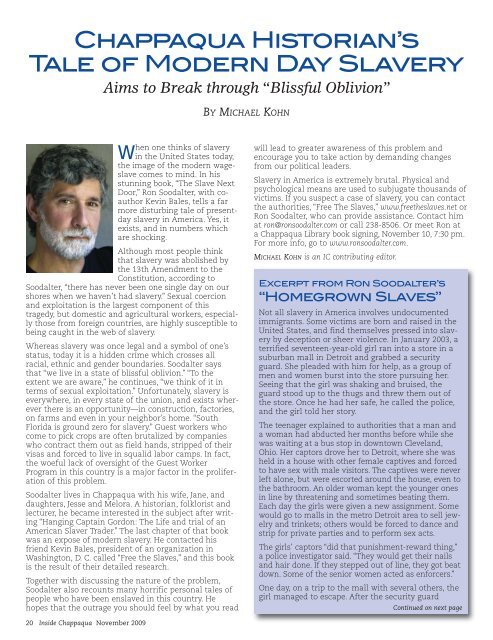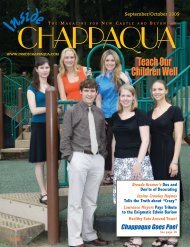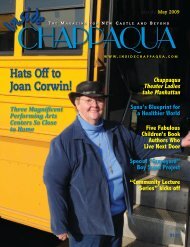Download the November 2009 issue (PDF) - Inside Chappaqua
Download the November 2009 issue (PDF) - Inside Chappaqua
Download the November 2009 issue (PDF) - Inside Chappaqua
Create successful ePaper yourself
Turn your PDF publications into a flip-book with our unique Google optimized e-Paper software.
<strong>Chappaqua</strong> Historian’sTale of Modern Day SlaveryAims to Break through “Blissful Oblivion”BY MICHAEL KOHNWhen one thinks of slaveryin <strong>the</strong> United States today,<strong>the</strong> image of <strong>the</strong> modern wageslavecomes to mind. In hisstunning book, “The Slave NextDoor,” Ron Soodalter, with coauthorKevin Bales, tells a farmore disturbing tale of presentdayslavery in America. Yes, itexists, and in numbers whichare shocking.Although most people thinkthat slavery was abolished by<strong>the</strong> 13th Amendment to <strong>the</strong>Constitution, according toSoodalter, “<strong>the</strong>re has never been one single day on ourshores when we haven’t had slavery.” Sexual coercionand exploitation is <strong>the</strong> largest component of thistragedy, but domestic and agricultural workers, especiallythose from foreign countries, are highly susceptible tobeing caught in <strong>the</strong> web of slavery.Whereas slavery was once legal and a symbol of one’sstatus, today it is a hidden crime which crosses allracial, ethnic and gender boundaries. Soodalter saysthat “we live in a state of blissful oblivion.” “To <strong>the</strong>extent we are aware,” he continues, “we think of it interms of sexual exploitation.” Unfortunately, slavery iseverywhere, in every state of <strong>the</strong> union, and exists wherever<strong>the</strong>re is an opportunity—in construction, factories,on farms and even in your neighbor’s home. “SouthFlorida is ground zero for slavery.” Guest workers whocome to pick crops are often brutalized by companieswho contract <strong>the</strong>m out as field hands, stripped of <strong>the</strong>irvisas and forced to live in squalid labor camps. In fact,<strong>the</strong> woeful lack of oversight of <strong>the</strong> Guest WorkerProgram in this country is a major factor in <strong>the</strong> proliferationof this problem.Soodalter lives in <strong>Chappaqua</strong> with his wife, Jane, anddaughters, Jesse and Melora. A historian, folklorist andlecturer, he became interested in <strong>the</strong> subject after writing“Hanging Captain Gordon: The Life and trial of anAmerican Slaver Trader.” The last chapter of that bookwas an expose of modern slavery. He contacted hisfriend Kevin Bales, president of an organization inWashington, D. C. called “Free <strong>the</strong> Slaves,” and this bookis <strong>the</strong> result of <strong>the</strong>ir detailed research.Toge<strong>the</strong>r with discussing <strong>the</strong> nature of <strong>the</strong> problem,Soodalter also recounts many horrific personal tales ofpeople who have been enslaved in this country. Hehopes that <strong>the</strong> outrage you should feel by what you readwill lead to greater awareness of this problem andencourage you to take action by demanding changesfrom our political leaders.Slavery in America is extremely brutal. Physical andpsychological means are used to subjugate thousands ofvictims. If you suspect a case of slavery, you can contact<strong>the</strong> authorities, “Free The Slaves,” www.free<strong>the</strong>slaves.net orRon Soodalter, who can provide assistance. Contact himat ron@ronsoodalter.com or call 238-8506. Or meet Ron ata <strong>Chappaqua</strong> Library book signing, <strong>November</strong> 10, 7:30 pm.For more info, go to www.ronsoodalter.com.MICHAEL KOHN is an IC contributing editor.Excerpt from Ron Soodalter’s“Homegrown Slaves”Not all slavery in America involves undocumentedimmigrants. Some victims are born and raised in <strong>the</strong>United States, and find <strong>the</strong>mselves pressed into slaveryby deception or sheer violence. In January 2003, aterrified seventeen-year-old girl ran into a store in asuburban mall in Detroit and grabbed a securityguard. She pleaded with him for help, as a group ofmen and women burst into <strong>the</strong> store pursuing her.Seeing that <strong>the</strong> girl was shaking and bruised, <strong>the</strong>guard stood up to <strong>the</strong> thugs and threw <strong>the</strong>m out of<strong>the</strong> store. Once he had her safe, he called <strong>the</strong> police,and <strong>the</strong> girl told her story.The teenager explained to authorities that a man anda woman had abducted her months before while shewas waiting at a bus stop in downtown Cleveland,Ohio. Her captors drove her to Detroit, where she washeld in a house with o<strong>the</strong>r female captives and forcedto have sex with male visitors. The captives were neverleft alone, but were escorted around <strong>the</strong> house, even to<strong>the</strong> bathroom. An older woman kept <strong>the</strong> younger onesin line by threatening and sometimes beating <strong>the</strong>m.Each day <strong>the</strong> girls were given a new assignment. Somewould go to malls in <strong>the</strong> metro Detroit area to sell jewelryand trinkets; o<strong>the</strong>rs would be forced to dance andstrip for private parties and to perform sex acts.The girls’ captors “did that punishment-reward thing,”a police investigator said. “They would get <strong>the</strong>ir nailsand hair done. If <strong>the</strong>y stepped out of line, <strong>the</strong>y got beatdown. Some of <strong>the</strong> senior women acted as enforcers.”One day, on a trip to <strong>the</strong> mall with several o<strong>the</strong>rs, <strong>the</strong>girl managed to escape. After <strong>the</strong> security guardContinued on next page20 <strong>Inside</strong> <strong>Chappaqua</strong> <strong>November</strong> <strong>2009</strong>















